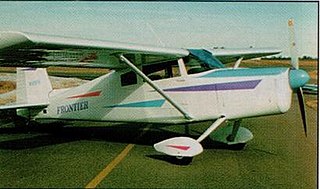History
The original L.A.5 Major was a two-seat light aircraft powered by a 62 hp Walter Mikron II engine. It was designed by C.H. Latimer-Needham, and built in 1939 by Luton Aircraft Limited at its Phoenix Works, Gerrards Cross, Buckinghamshire. The prototype (G-AFMU), designated L.A.5 Major, first flew on 12 March 1939. During 1943, the Phoenix Works burnt down, destroying the prototype, and causing the Luton Aircraft company to close. [2]
After World War II, Phoenix Aircraft Limited, formed by the designer C.H. Latimer-Needham and A.W.J.G. Ord-Hume, took over the design rights for the Luton Major. Latimer-Needham updated the design to make it more suitable for homebuilding, in which form it has become L.A.5A Major, with plans marketed by Falconar Avia of Edmonton, Alberta, Canada as the Cubmajor. An open cockpit version is marketed as the Majorette. [2] [3] [4]

The Flying Flea is a large family of light homebuilt aircraft first flown in 1933.

The Viking Dragonfly is an American amateur-built aircraft, designed by Bob Walters and produced by Viking Aircraft LLC of Elkhorn, Wisconsin. The aircraft is supplied as a kit or as plans for amateur construction.

The Luton L.A.4 Minor was a 1930s British single-seat high-wing ultra-light aircraft. The prototype was built by the Luton Aircraft Limited, and design plans were later adapted and copies sold for homebuilding.
Luton Aircraft Limited was a British aircraft manufacturer of Barton-in-the-Clay, Bedfordshire, and later Gerrards Cross, Buckinghamshire.

The Fauvel AV.36 was a single-seat tailless glider designed in France in the 1950s by Charles Fauvel. Although the "AV" in AV.36 stands for Aile Volante, it was not a true flying wing: it featured two large fins mounted on stubby tailbooms extending back from the wing's trailing edge, and accommodated the pilot within a stubby fuselage. The aircraft was designed to be quickly disassembled for road transport, with the nose detaching, and the fins able to fold back against the trailing edge of the wing. A refined version with a slightly longer wingspan, the AV.361 was introduced in 1960.
The Falconar Teal was a two-seat homebuilt, amphibious airplane designed by Chris Falconar of Edmonton, Alberta, Canada. From the 1970s to the 1990s plans were sold by Falconar Aviation of Edmonton. A handful were built by amateur aircraft constructors in Canada and the United States. Most were powered by certified Lycoming or Continental engines.
Cecil Hugh (Chookie) Latimer-Needham was a British aircraft designer, inventor and aviation author. He is best remembered for the series of aircraft he designed for the Luton Aircraft company and his invention of the Hovercraft skirt for which he was granted a patent. His book, Aircraft Design proved to be an invaluable reference work for Bill Goldfinch and Jack Best during their construction of the Colditz glider. The Germans were rather careless in providing a copy of the book in the Colditz prison library.
The Fauvel AV.45 was an unorthodox motor glider produced in France in the 1960s and 1970s. Like other Charles Fauvel designs, it was a tailless aircraft, in this case inspired by the work that German firms had done on producing motorised versions of his AV.36 design. The prototype of the AV.45 was an extensively modified AV.36 powered by a Nelson H-59 two-stroke engine. AV.45s have been built with a number of other engines, however, including at least one aircraft powered by a small turbojet. Falconar marketed the plans in the 1970s.

The PZL M-17 "Duduś Kudłacz" was a Polish twin-boom pusher general aviation and trainer aircraft of 1977, which remained a prototype.

The Jurca Gnatsum is a French homebuilt near scale replica aircraft based on the North American P-51 Mustang.

The RWD-16 was a Polish two-seat low-wing sports plane of 1936, constructed by the RWD team, that remained a prototype.

The Lederlin 380L is an unconventional light aircraft developed in France in the 1960s, and marketed for homebuilding.

The Falconar Golden Hawk is a Canadian tandem seat, pusher configuration, tricycle gear, canard-equipped ultralight aircraft that is offered in kit form by Falconar Avia of Edmonton, Alberta.
The Ganagobie is a single place, parasol wing homebuilt aircraft that was built by Willam and James Lobet, first flying in 1953.
The Falconar AMF-14H Maranda is a Canadian amateur-built aircraft, designed and originally produced by Falconar Avia for the Canadian basic ultralight class and US light-sport aircraft category. The aircraft is supplied as a kit or as plans for amateur construction.

The Falconar F12A Cruiser is a Canadian amateur-built aircraft, designed by Chris Falconar and originally produced as a kit by Falconar Avia. The aircraft is now supplied as plans for amateur construction by Manna Aviation.
The Falconar F9A and F10A are a family of Canadian amateur-built aircraft, that were designed by Chris Falconar and produced by Falconar Avia. The F9A design was introduced in 1965 and both the F9A and F10A were supplied as kits or as plans for amateur construction by Falconar. The F9A and F10A are now available in the form of plans from Manna Aviation.
The Falconar SAL Mustang, also called the 2/3 Mustang and the SAL P-51D Mustang is a Canadian amateur-built aircraft, originally produced by Falconar Avia and introduced in 1969. The aircraft is a 2⁄3 scale replica of the North American P-51 Mustang and is supplied as a kit or as plans for amateur construction.

The Falconar Minihawk is a Canadian amateur-built aircraft, originally produced by Falconar Avia. The aircraft is supplied as a kit or plans for amateur construction.

The Frontier MD-II was an American homebuilt aircraft that was designed and supplied as a kit by Frontier Aircraft Inc of Vail, Colorado, introduced in the 1990s.
This page is based on this
Wikipedia article Text is available under the
CC BY-SA 4.0 license; additional terms may apply.
Images, videos and audio are available under their respective licenses.












